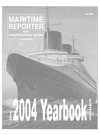
New Era for Gas Engines
With more than 300 lean-burn, spark-ignited gas engines supplied for stationary power applications over the past 15 years, Rolls-Royce is making a determined bid to break into the marine propulsion market with its newly-bolstered series of Norwegian-developed, gas-fueled Bergen engines. The preparation of the K-G4 type for shipboard use, plus the unveiling of the altogether more potent B35:40V-G design, have been driven by mounting environmental legislation and by national commitments to air pollution reduction attendant to the Kyoto Protocol.
While cognizant of the longer-term, international market scope, the business rationale in developing a marine offering of environmentally-friendly reciprocating prime movers, conceived for 100-percent operation on gas, has an immediate national relevance, given the opportunities presented by Norway's investment in its LNG fuel supply infrastructure. A government- inspired project for five gas-fuelled, doubleended road ferries to serve two of the country's longer fjord crossings is expected to provide an important platform for the technology, and the gradual extension of LNG bunkering points along the sea rim, coupled with a circumspect national energy policy, is expected to stimulate the uptake of gas-fuelled power and propulsion plant in coastal and offshore vessels. A small Norwegian LNG tanker and a modern tjord ferry currently use LNG as fuel in their high-speed engine plant, while two sophisticated offshore support vessels working Norwegian fields are distinguished by dual-fuel, medium-speed prime movers. The planned adoption of dual-fuel plant in French LNG carrier newbuilds has provided a fillip to the advocates of that technology. However, Rolls-Royce contends that its medium-speed, purely gasingesting machinery provides a simple, highly effective solution to low-emission powering needs, lending itself both to direct mechanical coupling to propellers and thrusters, and to shipboard electricity production. Moreover, test results have demonstrated that there are no operational limitations on sustained low load or transient operations.
Among the claimed advantages of employing lean-burn, gas-fuelled. Otto cycle engine technology are the low level of Nox (oxides of nitrogen) emission and the negligible release of Sox (oxides of sulfur) and particulates. LNG as a fuel has the attraction that its carbon content is lower than other hydrocarbon fuels such as diesel oil. If it is efficiently burned, the C02 (carbon dioxide) emissions from the engine are correspondingly low, a very positive factor for countries that have signed up to the Kyoto Agreement, and salient also to anticipated future international edicts governing C02 from ships' machinery.
An added economic benefit is that lube oil consumption is low, and oil change intervals are long.
The main frame and much of the running gear of the K-gas engine is derived from the successful Bergen K-series diesel engines used in hundreds of vessels.
A power output of 220-kW per cylinder is available, with running speeds between 600- and 1,000-rpm.
The K-G4 has been released in configurations of 6, 8 and 9 in-line cylinders, and in 12-. 16- and 18-cylinder veeform, covering unit powers to approximately 4,000-kW. If required at some later stage, K-gas engines can be converted for operation on marine diesel oil, and the company has also declared its readiness to convert K diesel engines to burn gas. A much larger, lean-burn, spark-ignition engine, founded on the B32:40 diesel engine hardware and Kgas engine technology, has been launched for unit power needs up to 8,800-kW. Offering 440-kW per cylinder, in vee-type models of 12, 16 and 20 cylinders, the B35:40V-G design is said to have a thermal efficiency of 47-percent.
Although the B-gas engine has been primarily conceived for the expanding market for reciprocating engines for stationary, industrial uses, the 350 mm-bore design offers scope as a marine power unit. In its 20-cylinder layout, the new Norwegian-built offering is claimed to be the world's most powerful spark-ignited, reciprocating gas engine.
Read New Era for Gas Engines in Pdf, Flash or Html5 edition of June 2004 Maritime Reporter
Other stories from June 2004 issue
Content
- New Joint Venture Tanker Company Sets Sail page: 9
- Crowley Refloats Stranded Passenger Ferry page: 10
- A Tradition Carried On page: 10
- EC: Spanish Shipyards Owe €308.3M page: 11
- Uljanik Delivers for Grimaldi-Napoli page: 12
- Washburn & Doughty delivers Independent page: 13
- Bollinger Repowers, Modifies 40-Year-Old Tug page: 14
- ACBL Announces Sweeping Changes page: 18
- Ocean Policy Study: Shortchanging Water Transport? page: 21
- Damen Delivers the Patrol Boat Valiant page: 25
- IZAR Christens LNG Ship page: 25
- Challenges facing IMO page: 26
- Flood Attracted to Water page: 30
- The Containership Market: Full Steam Ahead? page: 32
- Will Oil Continue Heading Up? page: 34
- Floating Production: The $8 Billion Market page: 36
- LNG Fleet Needs to Triple by 2020 page: 38
- New Free Fall Lifeboat Carries More People page: 41
- Wartsila to Power New DE Tanker page: 41
- Ice Tech: The Northern Promise page: 42
- New Era for Gas Engines page: 42
- Emulsion Breaking Bilge Water Cleaning System page: 44
- Balancing Security Safety and Commerce page: 46
- When the Clock Strikes Midnight page: 50
- The Layered Approach from a One-Stop-Shop page: 54
- JHOC: Eyes Wide Open page: 58
- The Posse Comitatus Act of 1878 page: 61
- Jacksonville Selects ObjectVideo's Solution page: 63
- Ship@Sight SSAS page: 63
- The Midas Touch page: 64
- Security and Safety: Questions & Answers page: 69
- Storm Warnings Raised over Readiness Concerns page: 70
- MACC 2004: Multi-Agency Craft Conference set for June 15-17 page: 76


